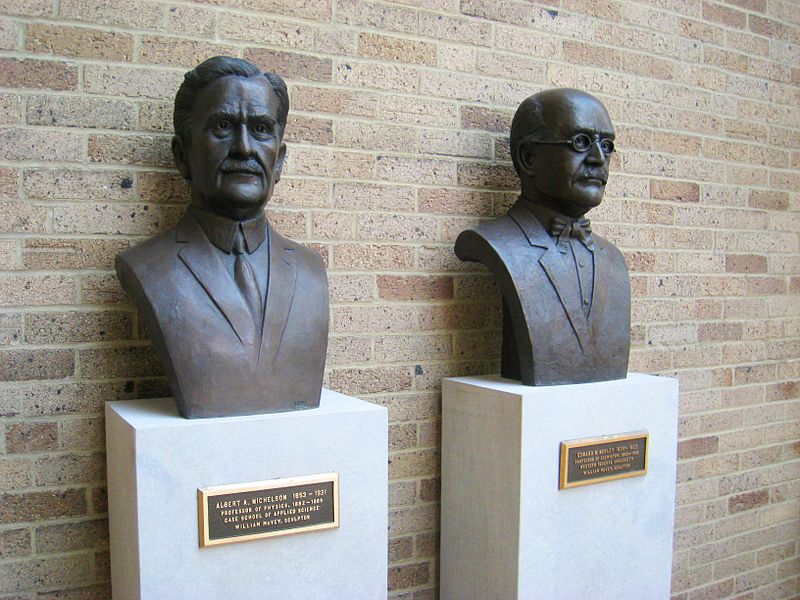<Back to Index>
- Physicist Albert Abraham Michelson, 1852
- Physicist and Chemist Edward Williams Morley, 1838
PAGE SPONSOR
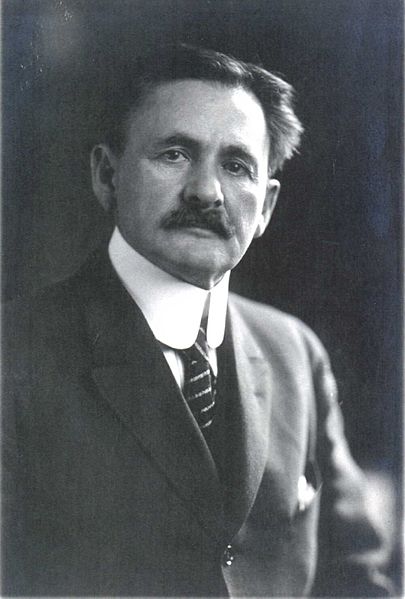
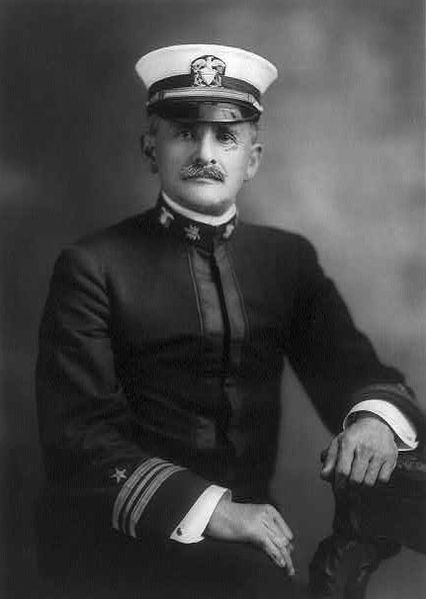
Albert Abraham Michelson (December 19, 1852 – May 9, 1931) was an American physicist known for his work on the measurement of the speed of light and especially for the Michelson - Morley experiment. In 1907 he received the Nobel Prize in Physics. He became the first American to receive the Nobel Prize in sciences.
Michelson was born in Strzelno, Provinz Posen in the Kingdom of Prussia (now Poland) into a Jewish family. He moved to the US with his parents in 1855, at the age of two. He grew up in the mining towns of Murphy's Camp, California, and Virginia City, Nevada, where his father was a merchant. He spent his high school years in San Francisco in the home of his aunt, Henriette Levy (née Michelson), who was the mother of author Harriet Lane Levy.
President Ulysses S. Grant awarded Michelson a special appointment to the U.S. Naval Academy in 1869. During his four years as a midshipman at the Academy, Michelson excelled in optics, heat, climatology and drawing. After graduating in 1873 and two years at sea, he returned to the Naval Academy in 1875 to become an instructor in physics and chemistry until 1879. In 1879, he was posted to the Nautical Almanac Office, Washington (part of the United States Naval Observatory), to work with Simon Newcomb. In the following year he obtained leave of absence to continue his studies in Europe. He visited the Universities of Berlin and Heidelberg, and the Collège de France and École Polytechnique in Paris.
Michelson was fascinated with the sciences, and the problem of measuring the speed of light in particular. While at Annapolis, he conducted his first experiments of the speed of light, as part of a class demonstration in 1877. His Annapolis experiment was refined, and in 1879, he measured the speed of light in air to be 299,864±51 kilometers per second, and estimated the speed of light in vacuum as 299,940 km/s, or 186,380 fps. After two years of studies in Europe, he resigned from the Navy in 1881. In 1883 he accepted a position as professor of physics at the Case School of Applied Science in Cleveland, Ohio, and concentrated on developing an improved interferometer. In 1887 he and Edward Morley carried out the famous Michelson - Morley experiment which seemed to rule out the existence of the aether. He later moved on to use astronomical interferometers in the measurement of stellar diameters and in measuring the separations of binary stars.
In 1889 Michelson became a professor at Clark University at Worcester, Massachusetts, and in 1892 was appointed professor and the first head of the department of physics at the newly organized University of Chicago.
In 1899, he married Edna Stanton. They raised one son and three daughters.
In 1907, Michelson had the honor of being the first American to receive a Nobel Prize in Physics "for his optical precision instruments and the spectroscopic and metrological investigations carried out with their aid". He also won the Copley Medal in 1907, the Henry Draper Medal in 1916 and the Gold Medal of the Royal Astronomical Society in 1923. A crater on the Moon is named after him.
Michelson died in Pasadena, California, at
the age of 78. The University of Chicago Residence Halls remembered
Michelson and his achievements by dedicating 'Michelson House' in his
honor. Case Western Reserve has dedicated a Michelson House to him, and
the chemistry academic building at the United States Naval Academy also bears his name. Clark University named a theater after him. Michelson Laboratory at Naval Air Weapons Station China Lake in
Ridgecrest, California, is named for him. There is a display in the
publicly accessible area of the Lab which includes facsimiles of
Michelson's Nobel Prize medal, the prize document, and examples of his
diffraction gratings.
As early as 1877, while still serving as an officer in the United States Navy, Michelson started planning a refinement of the rotating - mirror method of Léon Foucault for measuring the speed of light, using improved optics and a longer baseline. He conducted some preliminary measurements using largely improvised equipment in 1878, about the same time that his work came to the attention of Simon Newcomb, director of the Nautical Almanac Office who was already advanced in planning his own study. Michelson published his result of 299,910±50 km/s in 1879 before joining Newcomb in Washington DC to assist with his measurements there. Thus began a long professional collaboration and friendship between the two.
Simon Newcomb,
with his more adequately funded project, obtained a value of
299,860±30 km/s, just at the extreme edge of consistency
with Michelson's. Michelson continued to "refine" his method and in 1883
published a measurement of 299,853±60 km/s, rather closer
to that of his mentor.
In 1906, a novel electrical method was used by E.B. Rosa and N.E. Dorsey of the National Bureau of Standards to obtain a value for the speed of light of 299,781±10 km/s. Though this result has subsequently been shown to be severely biased by the poor electrical standards in use at the time, it seems to have set a fashion for rather lower measured values.
From 1920, Michelson started planning a definitive measurement from the Mount Wilson Observatory, using a baseline to Lookout Mountain, a prominent bump on the south ridge of Mount San Antonio (Old Baldy), some 22 miles distant.
In 1922, the U.S. Coast and Geodetic Survey began two years of painstaking measurement of the baseline using the recently available invar tapes. With the baseline length established in 1924, measurements were carried out over the next two years to obtain the published value of 299,796±4 km/s.
Famous as the measurement is, it was beset by problems, not least of which was the haze created by the smoke from forest fires which blurred the mirror image. It is also probable that the intensively detailed work of the geodetic survey, with an estimated error of less than one part in 1 million, was compromised by a shift in the baseline arising from the Santa Barbara earthquake of June 29, 1925, which was an estimated magnitude of 6.3 on the Richter scale.
The now famous Michelson - Morley Experiment also influenced the affirmation attempts of peer Albert Einstein's theory of general relativity and special relativity,
using similar optical instrumentation. These instruments and related
collaborations included the participation of fellow physicists Dayton Miller, Hendrick Lorentz, and Robert Shankland.
The period after 1927 marked the advent of new measurements of the speed of light using novel electro - optic devices, all substantially lower than Michelson's 1926 value.
Michelson
sought another measurement, but this time in an evacuated tube to avoid
difficulties in interpreting the image owing to atmospheric effects. In
1930, he began a collaboration with Francis G. Pease and Fred Pearson to perform a measurement in a 1.6 km tube at Pasadena, California. Michelson died with only 36 of the 233 measurement series completed and
the experiment was subsequently beset by geological instability and
condensation problems before the result of 299,774±11 km/s,
consistent with the prevailing electro - optic values, was published posthumously in 1935.
In 1887 he collaborated with colleague Edward Williams Morley of Western Reserve College, now part of Case Western Reserve University, in the Michelson - Morley experiment. Their experiment for the expected motion of the Earth relative to the aether, the hypothetical medium in which light was supposed to travel, resulted in a null result. Surprised, Michelson repeated the experiment with greater and greater precision over the next years, but continued to find no ability to measure the aether. The Michelson - Morley results were immensely influential in the physics community, leading Hendrik Lorentz to devise his now famous Lorentz contraction equations as a means of explaining the null result.
There has been some historical controversy over whether Albert Einstein was aware of the Michelson - Morley results when he developed his theory of special relativity,
which pronounced the aether to be "superfluous". Regardless of
Einstein's specific knowledge, the experiment is today considered the
canonical experiment in regards to showing the lack of a detectable
aether.
From 1920 and into 1921 Michelson and Francis G. Pease became the first individuals to measure the diameter of a star other than the Sun. They used an astronomical interferometer at the Mount Wilson Observatory to measure the diameter of the super - giant star Betelgeuse. A periscope arrangement was used to obtain a densified pupil in the interferometer, a method later investigated in detail by Antoine Émile Henry Labeyrie for use in "Hypertelescopes". The measurement of stellar diameters and the separations of binary stars took up an increasing amount of Michelson's life after this.
A
century later, the specific interferometer instrumentation design
produced by Albert Michelson has become the principle means to conduct astronomical interferometry. The "Michelson Interferometer" design is found on modern operational observatories such as VLTI, CHARA -- and the U.S. Navy's NPOI.
In an episode of the television series Bonanza (Look to the Stars, broadcast March 18, 1962), Ben Cartwright (Lorne Greene) helps the 16 year old Albert Abraham Michelson (portrayed by 25 year old Douglas Lambert (1936 – 1986)) obtain an appointment to the U.S. Naval Academy, despite the opposition of the bigoted town schoolteacher (played by William Schallert). Bonanza was set in and around Virginia City, Nevada, where Michelson lived with his parents prior to leaving for the Naval Academy. In a voice - over at the end of the episode, Greene mentions Michelson's 1907 Nobel Prize.
The home in which Michelson lived as a child in Murphys Camp, California, is now a tasting room for Twisted Oak Winery.
New
Beast Theater Works in collaboration with High Concept Laboratories
produced a "semi-opera" about Michelson, his obsessive work style and
its effect on his family life which ran from February 11 to February 26,
2011 in Chicago at The Building Stage. Michelson was portrayed by Jon
Stutzman. The play was directed by Davaid Maral with music composed by
Joshua Dumas.
Michaelson was a member of the Royal Society, the National Academy of Sciences, the American Physical Society and the American Association for the Advancement of Science.
The Computer Measurement Group gives an annual A. A. Michelson Award.
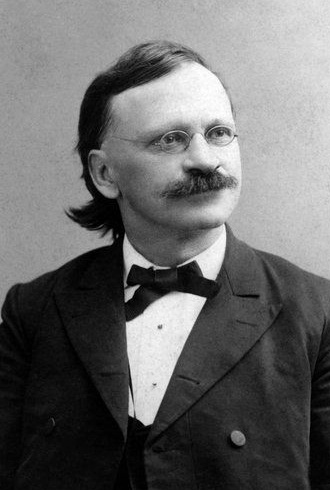
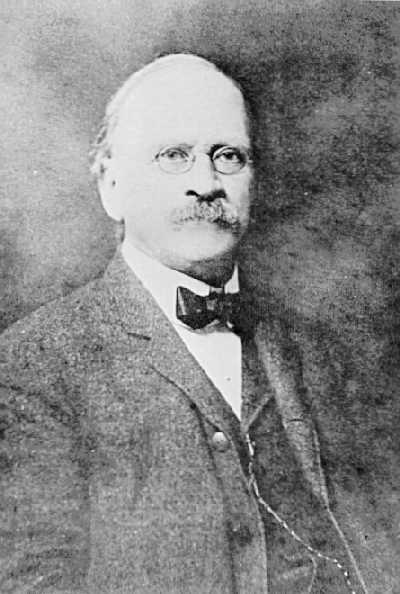
Edward Williams Morley (January 29, 1838 – February 24, 1923) was an American scientist famous for the Michelson – Morley experiment.
Morley was born in Newark, New Jersey, to Anna Clarissa Treat and the Reverend Sardis Brewster Morley. Both parents were of early colonial ancestry and of purely British origin. Morely grew up in West Hartford, Connecticut. During his childhood, he suffered much from ill health and was therefore educated by his father at home until the age of nineteen.
In 1857, Morley entered Williams College at Williamstown, Massachusetts, his father’s alma mater. He graduated in 1860 as A.B., and in 1863 received his master’s degree. Around 1960 he gradually shifted his attention from chemistry, which fascinated him since he was child, to optics and astronomy. In 1860 – 61 he mounted a transit instrument, constructed a chronograph, and made the first accurate determination of the latitude of the college observatory. This determination was the subject of his first published paper, which was read before the American Association for the Advancement of Science in 1866.
Upon advise of his parents, Morley entered Andover Theological Seminary in 1861 and completed the course in 1864. It was here, probably, that he acquired a good working knowledge of Hebrew. From 1866 to 1868 he was a teacher in a private school, and later, in 1868, he was called to preach in a small country parish in Ohio. At about the same time, he was appointed professor of chemistry in Western Reserve College (then situated at Hudson, Ohio, and later moved to Cleveland and renamed Case Western Reserve University), where he remained until his retirement in 1906. This appointment was the turning point in his career. In 1873 he also became professor of chemistry in Cleveland Medical College, but resigned this chair in 1888 to have more time for research. Just before moving to Hudson he married Miss Imbella A. Birdsall.
During his residence in Cleveland, Morley assembled one of the best private collections of chemical periodicals in America. He even included Russian journals and learned enough of the Russian language to use them. After his retirement from teaching, the university purchased his library and relocated to the chemical laboratory named after him. In 1906, Morley moved to West Hartford, Connecticut, where he built a small house and a laboratory for his personal studies of rocks and minerals.
Morley
was not a voluminous writer and published only 55 articles. He outlived
his wife by only a few months, and died, following a surgical
operation, in the Hartford Hospital in 1923.
Morley's most significant work came in the field of physics and optics. In this, Morley collaborated with and assisted the physicist Albert A. Michelson for several years around 1887. They set up, executed, and improved their techniques many times in what we call the Michelson – Morley experiment. This one involved making more and more accurate measurements of the speed of light in various directions, and at different times of the year as the Earth revolved in its orbit around the Sun. These careful measurements were created to measure the differences in the speed of light in different directions. Michelson and Morley always found that the speed of light did not vary at all depending on the direction of measurement, or the position of the Earth in its orbit. This was what we call a "null result" for their speed - of - light experiments.
Neither he nor Michelson ever considered that these null results disproved the hypothesis of the existence of "luminiferous aether", in which electromagnetic waves were thought to be propagated. Their null results led the Irish physicist George Francis FitzGerald to postulate what we now call the FitzGerald - Lorentz contraction of physical objects in the direction of their movement in inertial frames of reference.
However, other scientists did come to the conclusion that the aether did not exist. The results of the Michelson - Morley experiments soon led to Albert Einstein's strong postulate that the speed of light is a constant in all inertial frames of reference for his Special Theory of Relativity.
Morley also collaborated with Dayton Miller on positive aether experiments after his work with Michelson, and Morley himself made measurements of the speed of light when it passes through a strong magnetic field. Morley also studied the thermal expansion of solid materials.
In Western Reserve College, Morley was required to teach, not only chemistry, but also geology and botany that left him little time for research. Nevertheless, he found time during the first ten years at Hudson to publish five articles, mostly on the accuracy of measurements.
In chemistry, his original field, Morley had worked on determining accurate values for the composition of the atmosphere and
the weights of its gases. His work on the atomic weight of oxygen
covered a period of eleven years. Much time was spent in the calibration
of instruments and improving the measurement accuracy to the highest
possible degree (ca. 1 part per 10,000).
Morley was the president of the American Association for the Advancement of Science in 1895, and he was the president of the American Chemical Society in 1899. Morley was awarded the Davy Medal, named for the great British chemist Sir Humphrey Davy, by the Royal Society of London, England, in 1907, and he also won the Elliott Cresson Medal, awarded by the Franklin Institute of Pennsylvania, in 1912, for important contributions to the science of chemistry. He had received the Willard Gibbs Medal of the Chicago Section of the American Chemical Society in 1899.
The lunar crater Morley on the near side was named for him. The Morley Elementary School in West Hartford Conn. was also named for him. His house in West Hartford was made a National Historic Landmark in 1975.
